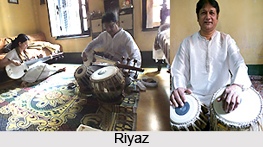 Vistar is regarded as the soul of Indian classical music. It is considered as having enormous importance in rendering music in all tradition of Indian music, especially Hindustani vocal music. The word `Manadharma` meaning law of mind is a Sanskrit word that stands for the art of Vistar. Manadharma refers to the stage where musician raises himself to the level of imagination that remains quite distinct from logical thinking. He actually engages himself in a form of mental state that utilizes only the laws of aesthetics. It is at this level that the thinking and feeling both unites into one integrated process. This exclusive integrated process that is derived from the creation of music is what is known as the Manadharma.
Vistar is regarded as the soul of Indian classical music. It is considered as having enormous importance in rendering music in all tradition of Indian music, especially Hindustani vocal music. The word `Manadharma` meaning law of mind is a Sanskrit word that stands for the art of Vistar. Manadharma refers to the stage where musician raises himself to the level of imagination that remains quite distinct from logical thinking. He actually engages himself in a form of mental state that utilizes only the laws of aesthetics. It is at this level that the thinking and feeling both unites into one integrated process. This exclusive integrated process that is derived from the creation of music is what is known as the Manadharma.
The musician of Hindustani Music represents a raaga primarily through the process of Vistar. The musicians are evaluated chiefly by their ability to improvise. The art of improvisation in music has been popular among many musical systems of the world that also includes those in the Middle East and Sub Saharan Africa and the gamelan music of Java and Bali. However the distinctive improvisatory style of Indian music or Vistar of Hindustani Music has been recognized and acknowledged by all as the most developed, most systematized and most sophisticated improvisatory style in the world.
Style of Vistar
The large amount of freedom that is given to the musician during the development of raaga makes it a distinctive pattern of in Hindustani Music. However at the same time strict rules are required to be followed to the last finite detail to maintain the purity of Raga during its presentation.
A musician on one hand is granted total liberation of imagination for improvisation of a Raga and on the other hand strict adherence is also levied on them to adhere to the prescribed framework of the given Raaga. It is this particular feature of boundlessness within the unbreakable boundary of a Raaga that composes the Vistar. This unique and exclusive concept of Indian classical music is referred to as the soul of Hindustani music.
Among all genres in Hindustani music, Khayal is the most important vocal genre that allows its performers the greatest opportunity and also the greatest challenge to display the depth of their musical knowledge and skills. It also renders them the best and the finest platform for Vistar. During a Khayal presentation the intricacies and nuances of any given raaga are best delivered by utilizing these tools and techniques of Vistar. They are used for creating all kinds of ornamentation while rendering a Raaga.
Based on the fundamentals, there are specific ways in which Vistar is carried out. Each specific ways has special characteristics of its own. Therefore there are different types of Vistar. These fundamentals or the basic tools and the various types of Vistar together constitute the concept of Vistar in Hindustani vocal music.




















